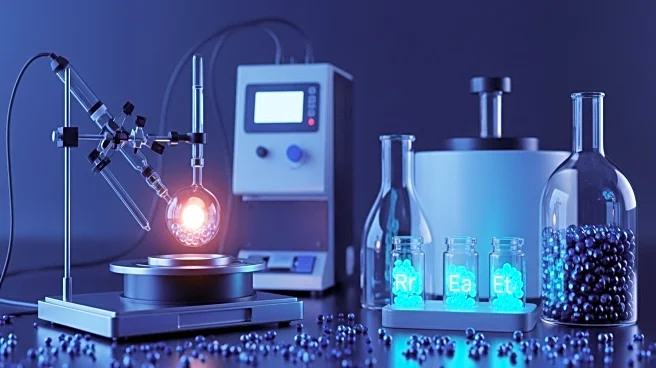What's Happening?
South Africa has achieved a significant breakthrough in the optimization of rare earth elements, producing an exceptionally pure product in a Johannesburg laboratory. This development is part of the ongoing rare earths recovery project led by Rainbow Rare Earths CEO George Bennett. The project focuses on recovering and separating rare earth elements from phosphogypsum stacks, a waste product from phosphoric acid production. This innovative approach eliminates many costs and risks associated with traditional mining. The laboratory testwork has successfully maximized rare earth element recovery at 65% while achieving impurity rejection through continuous ion exchange. The purification process combines ion exchange and precipitation steps, showcasing Rainbow's intellectual property in rare earth extraction. The project aims to become a low-cost producer of light and heavy rare earth elements, with a high economic grade of rare earths in the gypsum stacks at Phalaborwa.
Why It's Important?
The optimization of rare earth elements in South Africa is crucial as these elements are in high demand for use in permanent magnets, essential for green technologies and advanced products. The project positions South Africa as a pioneer in the commercial recovery of rare earths from phosphogypsum, potentially becoming one of the highest margin projects globally. This development is significant for the West, which is increasingly recognizing the importance of rare earth elements. The project could lead to a more resilient supply chain for these critical materials, reducing dependency on traditional mining and offering a sustainable solution. The economic implications are substantial, with potential savings in power, reagent, labor, and capital costs, enhancing the project's feasibility and attractiveness to investors.
What's Next?
The next steps involve trade-off studies to optimize the primary leach circuit, which will provide updates on the potential impact on capital and operational expenditures. The publication of the project's definitive feasibility study is anticipated, which will further detail the economic viability and potential market impact. The project is expected to produce 150,000 tons of rare earths over a 16-year life span, with operational costs believed to be the lowest in the West. This positions the project as a frontrunner in the rare earths industry, potentially influencing global supply chains and market dynamics.
Beyond the Headlines
The project not only addresses the economic aspects but also environmental concerns, as it aims to clean up environmentally hazardous gypsum stacks in an eco-friendly manner. This aligns with global efforts to promote sustainable mining practices and reduce environmental impact. The collaboration with Mintek, South Africa's Council for Mineral Technology, highlights the integration of advanced technology and expertise in mineral extraction, setting a precedent for future projects in the industry.

